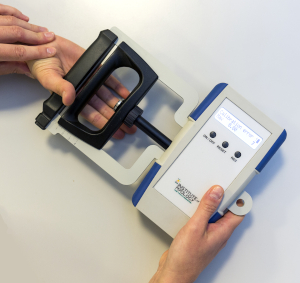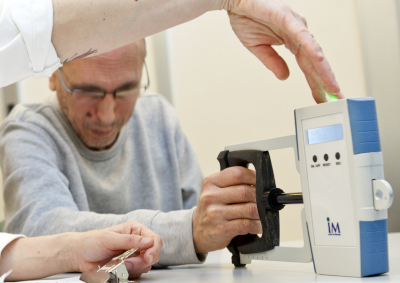
The team at the Neuromuscular Physiology and Evaluation Laboratory of the Institute of Myology participated with, in particular, clinicians from I-Motion, in a study intended to assess grip strength in patients with Duchenne Muscular Dystrophy. The results were published in March 2020, in the Journal of Neurology*. Interview with Jean-Yves Hogrel, Head of the Laboratory.
What are the origins of the project?
We started from the general observation at the beginning of the 2000s that, at that stage, there were very few tools to assess very weak neuromuscular patients. The conventional assessment tools were ineffective, to say the least, and did not allow one to detect the strength of these patients, which was weak but not non-existent. This could result in a certain degree of frustration for patients faced with the difficulty of obtaining quantifiable results. Therefore, we took the decision to develop several tools in order to be able to suitably test, assess and assist our patients being followed up at the Neuro-Myology Department and at the Physiology and Neuromuscular Assessment Laboratory. These tools included the MyoGrip dynamometer, which assesses grip strength, a major function of autonomy and something that is very important to these patients.
What does the assessment device being used consist of?
It was while studying and starting to assess neuromuscular disease patients with major muscle weakness that we had to accept the fact that the methods used up to that point were not satisfactory and that it was the right time to develop new tools.
 For example, the MyoGrip dynamometer (patented tool), a high-precision dynamometer to assess grip strength, which was used in this study. The first prototype was created in 2001, and a mature solution was validated by an initial study (called Myotools), conducted between 2007 and 2009. It was possible to conduct patient assessments using the MyoGrip at several Téléthons and Family Days.
For example, the MyoGrip dynamometer (patented tool), a high-precision dynamometer to assess grip strength, which was used in this study. The first prototype was created in 2001, and a mature solution was validated by an initial study (called Myotools), conducted between 2007 and 2009. It was possible to conduct patient assessments using the MyoGrip at several Téléthons and Family Days.
This tool, and indeed all our Myotools, are tools with a high degree of precision across their entire measurement scale. For example, we can measure a grip strength of between 0 and 90 kg to an accuracy of 50 g and a resolution of 10 g.
Our tools are all conceived and developed with clinicians and are the subject of several validation studies. Their metrological properties are being measured, measurement protocols and settings are being validated, and standards and reference models are been developed.
In this study, patient age was used as a reference indicator to express strength not in terms of absolute values, but in terms of values predicted for age. The prediction model is based on an equation relating age to grip strength established from measurements on more than 350 control subjects.
The results demonstrated that it is possible to detect muscle strength for all patients, including the weakest. This is the situation of non-ambulatory patients, who have been excluded from therapeutic trials due to a lack of suitable measurement methods.
What are the study objectives?
The objective of this study was to build a natural history of the grip strength of patients with Duchenne Muscular Dystrophy (DMD), 5 to 30 years of age and being followed up in studies of the natural history of the disease.
Which methods were used to test and assess the patients?
We first collected data from different international clinical studies to conduct a meta-analysis. These data came from over 200 patients followed up over a period of more than two years, representing almost 1000 measurement points.
We began a first study in 2009, which lasted a total of 4 years, the follow-up of each patient was 2 years. Then, an number of other studies followed using different tools that made it possible to assess the patients at different levels of exploration: strength (grip, pinch, extension, flexion of the wrist, etc.), respiratory measurements (vital capacity, volume and lung pressure, etc.), imaging (muscle volume, fatty infiltration, etc.) and function measurements (measurement of motor function, walking, etc.)
The grip measurements were made using the MyoGrip tool.
What results were obtained?
This study revealed an important aspect of grip strength. We noted that when strength was expressed as an absolute value (in kg), patients were very heterogenous. Indeed, up to approximately 12 years of age, grip strength increases and growth partly compensates for muscle degeneration resulting from their disease. Beyond that age, a decrease in strength is observed among these patients, who often become non-ambulatory
If this same strength is expressed as a relative value (in percentage of strength predicted for age), it is observed that DMD patients begin to lose strength before 5 years of age, in a gradual and continuous manner. Measuring strength using relative values allows the confounding effect of growth and/or age to be erased.
With this dynamometer, we are therefore able to follow-up a patient regardless of his/her clinical status, whether ambulatory or not, and whether receiving treatment or not.
What conclusions can be drawn and what benefits has it been possible to measure for these patients?
This study made it possible to test and validate grip strength as a possible efficacy measurement for a treatment.
 Furthermore, this tool can be used for other types of disease where the patient is experiencing major muscle weakness, such as spinal muscular atrophy (SMA) and centronuclear (myotubular) myopathy (CNM).
Furthermore, this tool can be used for other types of disease where the patient is experiencing major muscle weakness, such as spinal muscular atrophy (SMA) and centronuclear (myotubular) myopathy (CNM).
For patients, the benefits of these protocols and these assessment measurements are obvious. Thanks to the sensitivity of the MyoGrip, it is possible to demonstrate in concrete terms that they still have a little muscle strength when, until then, the grips on the market were not sensitive enough to detect the weakest strengths.
The results are clearly visible using our tools, which can detect a very slight force and, in particular, small variations in strength over time. This can be important as things stand in terms of therapeutic approaches.
Finally, thanks to this study, we are eager to make our tools and our methods known outside our Centre of Expertise in Neuromyology, since there are multiple applications for other diseases causing problems with grip: ageing, strokes, cancer, trauma, etc.
See also the interview on another MyoTool, Development of MyoQuad to evaluate quadriceps strength
